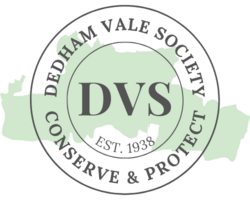Our Work
We devote the majority of our resources to campaigning and lobbying national and local government departments, planning teams and developers. We take action to challenge development, larger-scale infrastructure projects and other commercial activities, which if left unchecked, will threaten:
- the character of the Dedham Vale's historic built environment
- the unspoilt and tranquil landscapes unique to the Dedham Vale
- the bio-diversity and protected wildlife habitats across the Dedham Vale
Preserve the vernacular architecture of the built environment
Through the Society we celebrate and try to preserve the vernacular architecture of the Vale and its ancient buildings many of which date from the medieval wool trade. The expert knowledge and experience of our committee members has been central in consulting with local plans and promoting village design statements to enshrine what local residents think is important about the character of the area.
Our membership has, over the years, included many distinguished architects, from Marshall Sisson, who gave the early 18th century Sherman’s Hall in Dedham High Street to the National Trust in 1949, to Raymond Erith who built the waterworks buildings in Dedham that resemble classical orangeries instead of the concrete monstrosities once threatened.
We have also been able to call on the skills of Erith’s successor, Quinlan Terry, who has played a part in the maintenance of the churches of the Vale and, in the design of Frog Meadow, Dedham, in pioneering the revival of traditional styles of architecture in infill housing in the 1970s, as the Prince of Wales was to do later in Poundbury.
Protecting the sky at night and our treasured landscapes
Ronald Blythe once wrote of the Vale: The skies are famously high and there are many more trees than when Constable walked to his uncle's farm a mile or two away.
The gulls still follow the huge ploughs in screaming flocks but the agricultural landscape is now strangely uninhabited, as Blythe also remarked. Gainsborough and Constable would have found it strange: their landscapes were all toil.
We at the Dedham Vale Society have tried since 1938 to preserve the views that people are lured to by great art. Often this has meant campaigning successfully against electricity wires in villages and against the march of pylons across protected landscapes.
One of our Society's latest campaigns is to protect landscapes of the Vale from intense housing pressure by extending the AONB as far as Cornard, painted by Gainsborough. We also have a campaign to protect the sky at night by getting the Vale internationally recognised as a Dark Sky Park.
Preserving the rural environment for native and migratory wildlife and encouraging bio-diversity
Whether it is preserving the memory of the elm tree, the loss of which to disease since 1967 has meant so much to the landscapes of the Vale, or charting the gradual resurgence over the years of the otter and polecat, the Society's newsletters are the place to go to understand the Vale's wildlife and how it has changed over time.
The river Stour used to see migratory fish such as sea trout as far up as Dedham Mill until the 1950s and probably until the tidal flood barrage was built at Cattawade In 1971. One of 15lbs was caught in the eel trap at Dedham mill in 1942. The eel is something else that has fallen drastically in abundance in the past few decades for unexplained reasons.
In the interests of wildlife, our society has campaigned to preserve the tranquility of the river from powered craft and to prevent lights from disturbing wildlife at night. We have also called for the preservation of orchards and the creation of 'pollinator patches' in villages. We also campaign against the annual massacre of wildflowers on the verges by local authority mowers.



